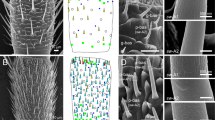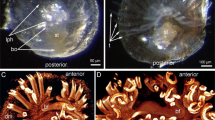Abstract
BRAIN neurosecretory cells have now been described in a large number of pterygote insect species. Most authors are agreed that there are normally two groups of these identifiable in each hemisphere of the brain, a median group lying close to the pars intercerebralis and a lateral group. In larvæ of Diptera-Cyclorrhapha descriptions exist of the former only (see Thomsen1).
This is a preview of subscription content, access via your institution
Access options
Subscribe to this journal
Receive 51 print issues and online access
$199.00 per year
only $3.90 per issue
Buy this article
- Purchase on Springer Link
- Instant access to full article PDF
Prices may be subject to local taxes which are calculated during checkout
Similar content being viewed by others
References
Thomsen, M., Dan. Biol. Skr., 6 No. 5 (1951).
Gomori, G., Amer. J. Path., 17, 395 (1941).
Gomori, G., Amer. J. Clin. Path., 20, 665 (1950).
Steedman, H. F., Quart. J. Micr. Sci., 91, 477 (1950).
Hinton, H. E., Entomologist, 86, 279 (1953).
Author information
Authors and Affiliations
Rights and permissions
About this article
Cite this article
FRASER, A. Neurosecretory Cells in the Brain of the Larva of Lucilia caesar L.. Nature 179, 257–258 (1957). https://doi.org/10.1038/179257a0
Issue Date:
DOI: https://doi.org/10.1038/179257a0
This article is cited by
-
Stress-like reaction ofDrosophila to adverse environmental factors
Journal of Comparative Physiology B (1987)
-
The genetics of esterases in Drosophila. VIII. The gene regulating the activity of JH-esterase in D. virilis
Biochemical Genetics (1984)
-
Neurosecretory cells in the thoracic ganglion of pupae ofCulex fatigans weidemann, 1828 (Diptera, Culicidae)
Die Naturwissenschaften (1966)
Comments
By submitting a comment you agree to abide by our Terms and Community Guidelines. If you find something abusive or that does not comply with our terms or guidelines please flag it as inappropriate.



